Interesting Facts About Ladybugs You Never Knew
Did you know ladybugs aren't actually bugs? They're beetles with hidden wings and diverse colors beyond the classic red and black. These voracious predators can devour up to 5,000 aphids in their lifetime, making them natural pest controllers. During winter, they enter diapause, hibernating in large groups to survive. Their bright colors serve as a warning to predators, while their name has religious origins tied to the Virgin Mary. Surprisingly, ladybugs can turn cannibalistic when food is scarce. Native populations are declining due to habitat loss and invasive species. There's much more to discover about these fascinating insects.
This post may contain affiliate links. If you make a purchase through these links, I may earn a commission at no additional cost to you. Additionally, portions of this post may be generated using artificial intelligence (AI) technology. While we strive for accuracy, please be aware that AI-generated content may not always be perfect and should be fact-checked when necessary.
The Spatula Scoops
- Ladybugs can eat up to 5,000 aphids in their lifetime, making them highly effective natural pest control agents.
- During winter, ladybugs enter diapause and can survive up to nine months using stored fat reserves.
- Some ladybug species practice cannibalism, consuming eggs, larvae, and newly emerged adults during food scarcity.
- Ladybugs have hidden membranous wings beneath their elytra, allowing for quick deployment and efficient flight.
- The name "ladybug" has religious origins, with seven spots symbolizing the Virgin Mary's joys and sorrows.
They're Not Actually Bugs
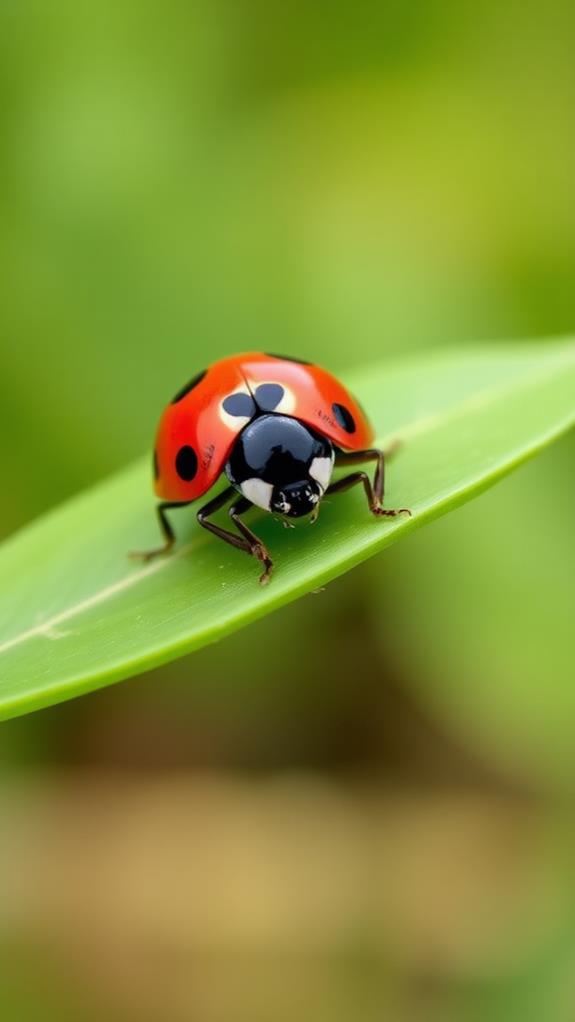
Despite their name, ladybugs aren't actually bugs at all. You might be surprised to learn that these colorful creatures belong to the beetle family, specifically the order Coleoptera. This classification sets them apart from true bugs, which have needle-like mouthparts for sucking liquids. Ladybugs, also known as ladybird beetles in many parts of the world, possess chewing mouthparts that allow them to consume a variety of insects and plant materials.
When you hear about ladybugs, you're actually referring to a diverse group of insects. There are approximately 5,000 species of these beetles worldwide, with about 450 found in North America alone. Their ability to chew is a key distinguishing factor from true bugs, enabling them to play important roles in various ecosystems.
You'll find that the terminology used to describe these insects varies depending on your location. In the United States, you're likely to hear them called ladybugs, while in Europe, they're more commonly known as ladybirds. This regional naming difference reflects the nuances in entomological terminology across different parts of the world.
Diverse Colors and Patterns
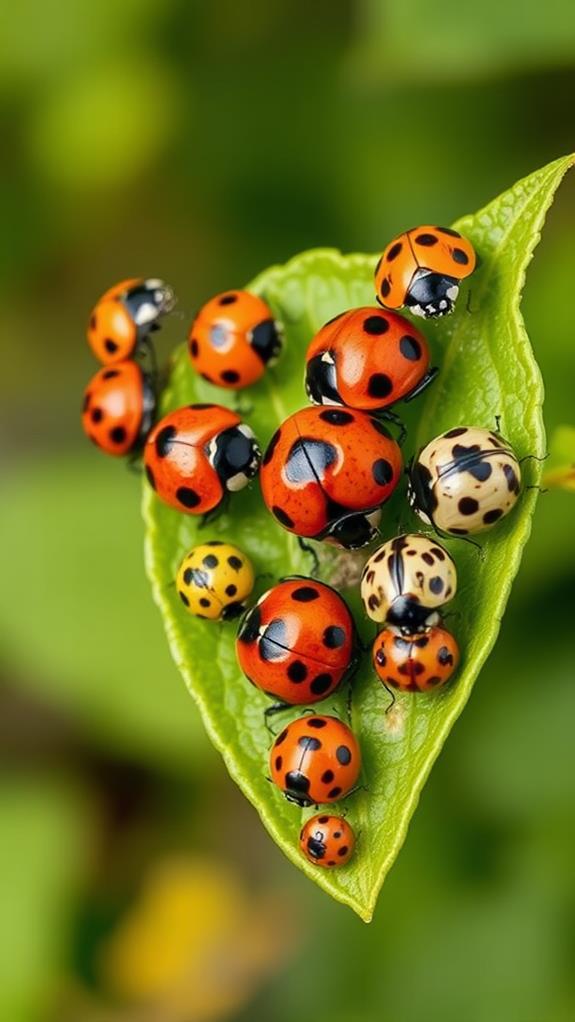
You might be surprised to learn that ladybugs come in a rainbow of colors beyond the classic red with black spots. These tiny beetles showcase an incredible array of diverse colors and patterns, including yellow, orange, brown, pink, and even solid black. Some species lack spots altogether, while others sport stripes or unique color combinations.
With approximately 5,000 ladybug species worldwide, and 450 in North America alone, the variety is astounding. These colorful appearances aren't just for show; they serve important purposes. The bright hues act as warning signals to predators, indicating potential distastefulness or toxicity. This defense mechanism, known as aposematism, helps protect ladybugs from being eaten.
Color variations also play a significant role in survival strategies. Some ladybugs use their patterns for camouflage, blending into their surroundings to avoid detection. Others mimic the appearance of more dangerous species, tricking predators into leaving them alone. This diversity in ladybug coloration demonstrates nature's incredible adaptability and the complex interplay between appearance and survival in the insect world.
Voracious Aphid Eaters
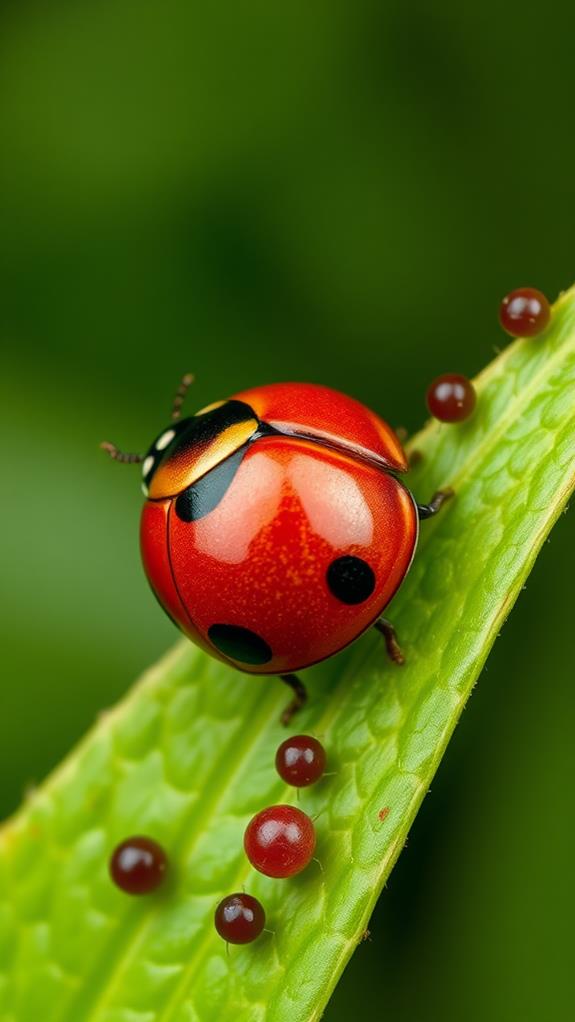
You might be surprised to learn that ladybugs are nature's aphid control champions. These tiny, colorful insects have an insatiable appetite for aphids, with adult ladybugs consuming up to 50 aphids per day and a staggering 5,000 over their lifetime. Female ladybugs are particularly voracious, capable of devouring around 75 aphids daily, making them invaluable allies in organic pest management for gardens and crops.
Aphid Control Champions
From within the world of beneficial insects, ladybugs stand out as true champions of aphid control. You might be surprised to learn that these small, colorful beetles are voracious predators, capable of consuming an astonishing number of aphids throughout their lifetime. A single adult ladybug can devour up to 5,000 aphids, while females can eat about 75 aphids daily. This impressive appetite makes ladybugs highly effective natural pest control agents for farmers' crops.
But it's not just the adults that contribute to aphid control. Ladybug larvae are equally predatory, consuming hundreds of aphids during their growth stage. This dual-generational approach to pest management amplifies the ladybug's role in controlling aphid populations. For organic farmers seeking environmentally friendly solutions, ladybugs are a preferred option. Their effectiveness in managing aphid infestations can markedly reduce crop damage and agricultural losses, which often amount to millions of dollars annually. By harnessing the power of these beneficial insects, farmers can protect their crops while minimizing the use of harmful pesticides, creating a more sustainable and eco-friendly approach to agriculture.
Insatiable Pest Devourers
Ladybugs aren't just cute garden ornaments; they're nature's pest control powerhouses. These insatiable pest devourers play an essential role in biological pest management, particularly when it comes to aphid control. You might be surprised to learn that adult ladybugs eat up to 50 aphids per day, with females consuming even more during their active feeding periods—up to 75 aphids daily.
Over their lifetime, a single ladybug can devour around 5,000 aphids, making them invaluable allies in your garden. This voracious appetite isn't limited to adult ladybugs; their larvae are equally impressive eaters, consuming hundreds of aphids as they grow. The impact of ladybugs on pest control is significant, helping to mitigate billions of dollars in agricultural losses caused by aphids worldwide each year.
When you invite ladybugs into your garden, you're enlisting a natural, efficient pest control force. Their insatiable appetite for aphids and other soft-bodied insects helps maintain a balanced ecosystem and promotes healthy plant growth. By understanding and harnessing the power of these tiny, spotted predators, you can reduce the need for chemical pesticides and support a thriving, pest-resistant garden.
Winter Hibernation Habits
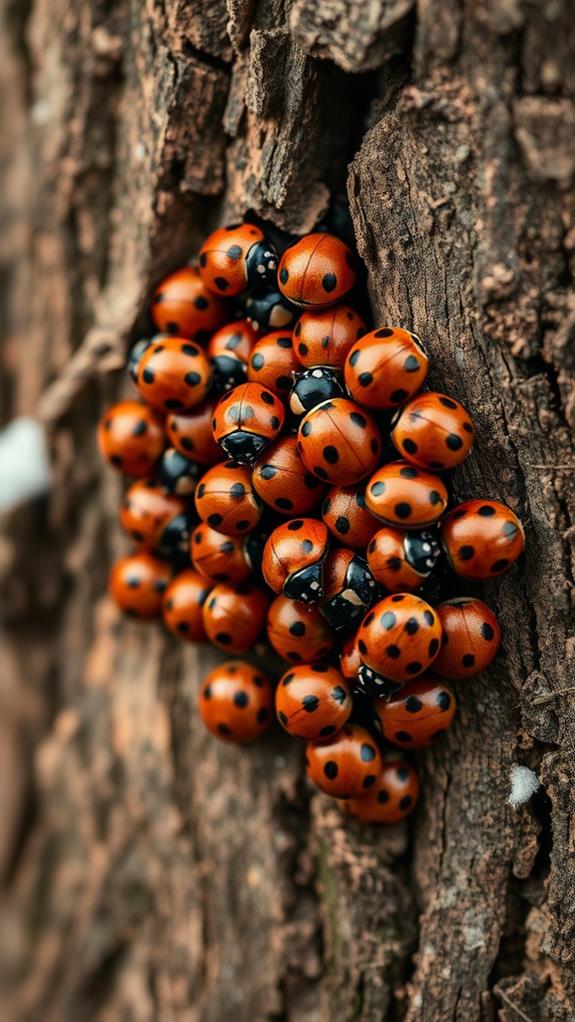
During winter, you'll find ladybugs entering a state called diapause, a survival strategy that allows them to hibernate and conserve energy. They'll seek out sheltered spots, often in large groups, to protect themselves from the cold and rely on their fat reserves for sustenance. You might be surprised to learn that ladybugs can travel significant distances to find suitable overwintering locations, which can include natural hideaways like rotting logs or even the cozy corners of your home.
Diapause Survival Strategies
Have you ever wondered how ladybugs survive harsh winters? These tiny creatures employ a remarkable survival strategy called diapause. As temperatures drop and food becomes scarce in late fall, ladybugs enter this state of suspended development. It's not quite hibernation, but it allows them to conserve energy and survive on stored fat reserves for up to nine months.
To prepare for diapause, you'll find ladybugs seeking out warm, sheltered locations. They might huddle in rotting logs, under rocks, or even inside your home. Curiously, ladybugs often form large aggregations during this time, sometimes numbering in the thousands. This behavior helps them conserve heat and increases their chances of survival.
During diapause, ladybugs' metabolism slows dramatically, allowing them to withstand cold temperatures and food scarcity. When spring arrives and temperatures warm up, these resilient insects emerge from their winter retreat. They resume their normal life cycle and feeding activities, ready to tackle the new season. This fascinating adaptation showcases the incredible ways nature has equipped even the smallest creatures to endure challenging environmental conditions.
Overwintering Location Choices
When winter's chill sets in, these charming spotted insects face a crucial decision: where to hunker down for the cold months ahead. Ladybugs, in their quest for survival, seek out sheltered spots that'll protect them from freezing temperatures. You'll find them congregating in rotting logs, under rocks, and even inside your home.
These clever creatures have a knack for overwintering in large groups, a strategy known as communal living. By huddling together, they maintain warmth and increase their chances of making it through harsh winter conditions. It's not uncommon to discover hibernation colonies containing thousands of ladybugs, especially the Asian multicolored variety.
During their winter slumber, ladybugs enter a state called diapause. They can survive for up to nine months by relying on fat reserves they've built up during warmer months. When choosing overwintering sites, ladybugs prioritize locations that offer ample shelter and protection from the elements. This selective process guarantees they have the best possible environment for their extended period of inactivity, maximizing their odds of emerging unscathed when spring arrives.
Defensive Warning Coloration
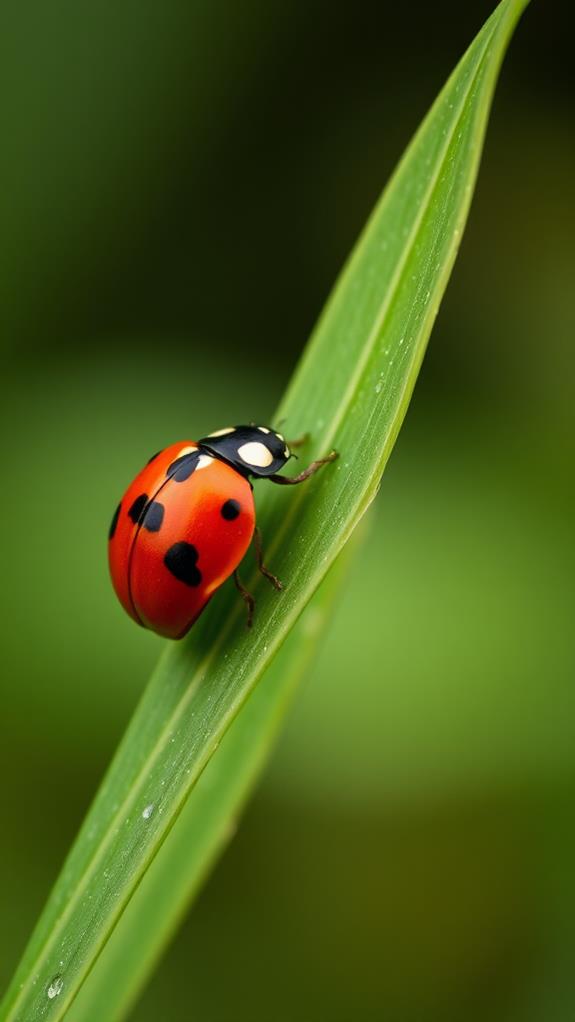
Nature's warning signs come in many forms, and ladybugs sport one of the most recognizable. You've likely noticed their bright colors and distinctive spots, but did you know these features serve as a powerful defense mechanism? Ladybugs use aposematic coloration, a visual strategy that warns potential predators of their unpalatability and possible toxicity.
When you see a ladybug's red or orange body adorned with black spots, you're witnessing an evolutionary marvel. These vibrant hues and patterns act as warning signals, effectively deterring birds and other predators from making a meal of these small beetles. But the defense doesn't stop there. If threatened, ladybugs can secrete a yellow, foul-smelling liquid called hemolymph, further reinforcing their unappetizing nature.
Contrary to popular belief, the spots on a ladybug don't indicate its age. Instead, they play a vital role in species identification and contribute to the overall warning display. This visual deterrent is so effective that many predators learn to associate the bright colors with an unpleasant taste or harmful effects, ensuring the survival of these beneficial insects in their ecosystems.
Origin of Their Name
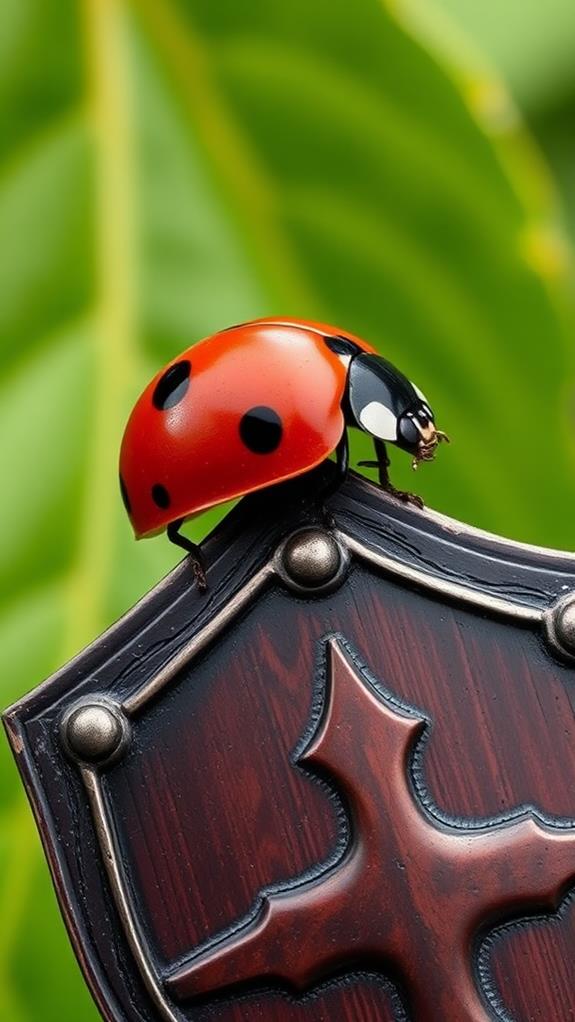
You might be surprised to learn that the name "ladybug" has deep religious roots. This common insect's moniker originated from the British term "ladybird," which refers to "Our Lady's bird," connecting it to the Virgin Mary. During the Middle Ages, farmers faced significant challenges with crop-destroying pests like aphids. In their desperation, they turned to the Virgin Mary for help.
When ladybugs appeared in fields, seemingly answering their prayers by devouring the harmful insects, they were seen as a miracle of protection. This perception led to the ladybug's revered status in agriculture and solidified its association with the Virgin Mary.
Here are four interesting facts about the ladybug's name origin:
- The seven spots on many ladybug species symbolize Mary's seven joys and sorrows.
- The term "ladybug" evolved from its medieval European roots.
- "Ladybug" became widely accepted in America, replacing "ladybird."
- The insect's name reflects its cultural significance and religious symbolism.
This etymology showcases how historical context and religious beliefs can shape the names we give to creatures in our environment, even influencing modern terminology.
Cannibalistic Survival Tactics
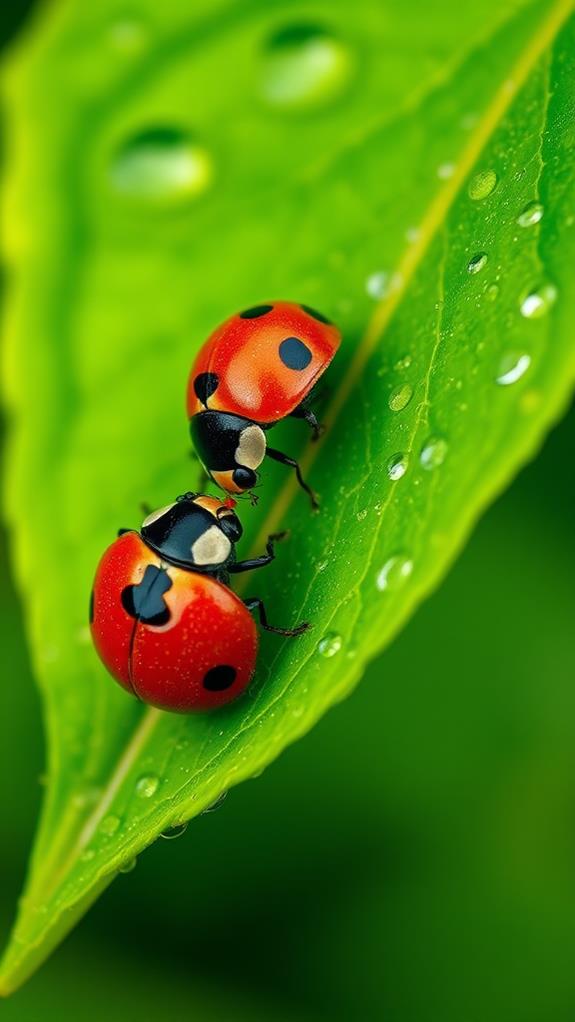
Beneath their colorful, cheerful exterior, ladybugs harbor a dark secret: they're capable of cannibalism. You might be surprised to learn that these adorable insects can turn on their own kind when food is scarce. This survival strategy showcases their adaptability to challenging environmental conditions.
When prey is limited, ladybugs may resort to consuming their own species. The most vulnerable targets are often newly emerged adults and recently hatched larvae, which are easier to eat. In extreme cases, you'll find ladybugs consuming their own eggs and pupae to guarantee their survival during tough times. This behavior reflects a resourceful approach to managing limited resources in their ecosystem.
While cannibalism among ladybugs isn't common, it's been documented in the wild. This fact illustrates the complexity of their dietary habits and survival instincts. You should understand that this behavior is a last resort for ladybugs, driven by necessity rather than preference. It's a stark reminder that even the most charming creatures in nature can exhibit surprising behaviors when faced with challenging circumstances. Ladybugs' cannibalistic tendencies underscore the harsh realities of survival in the insect world.
Hidden Wings for Flight
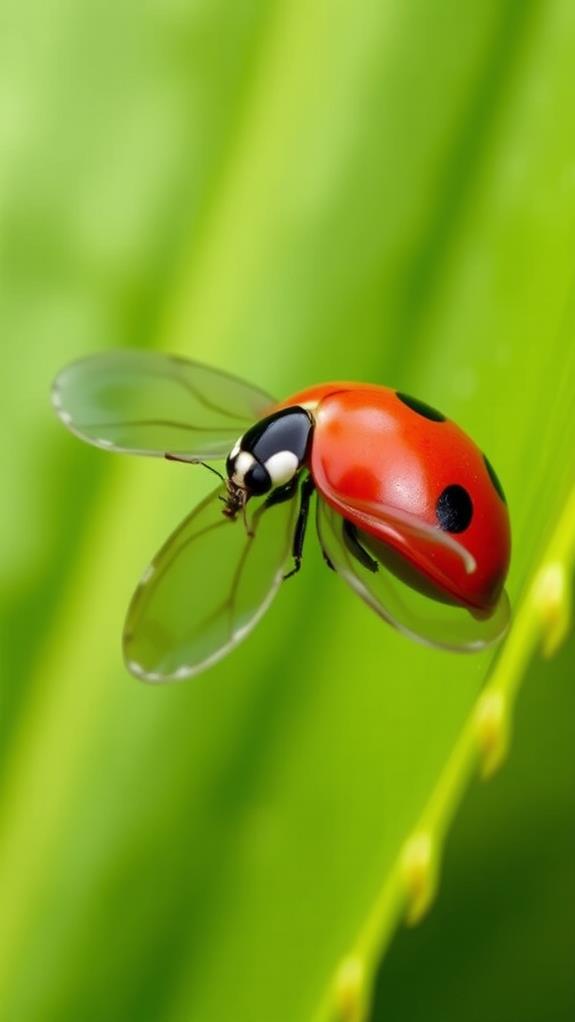
Ladybugs' secret superpower lies in their hidden wings. These beloved beetles possess a remarkable ability to quickly unfurl their wings when needed. You might not realize it, but underneath their colorful, spotted elytra (hard wing covers), ladybugs conceal delicate membranous wings. When it's time to fly, they lift their elytra and deploy their wings in a matter of seconds.
This hidden wing structure serves several vital purposes for ladybugs:
- Enables agile movement and quick escapes from threats
- Allows for efficient migration to new habitats
- Facilitates the search for food sources
- Aids in finding mates across wider areas
The wing design is perfectly adapted to the ladybug's small body size, providing an ideal balance between mobility and dispersal. When you see a ladybug take flight, you're witnessing a feat of natural engineering. Their wings expand rapidly, allowing these tiny insects to cover surprising distances. This ability to fly is essential for ladybugs' survival, as it helps them navigate changing environments and seasons. By understanding these hidden wings, you gain insight into the remarkable adaptations that make ladybugs such successful and widespread insects.
What Can Machu Picchu Teach Us About the Role of Ladybugs in Ancient Agriculture?
Machu Picchu unveils the ingenuity of ancient agricultural practices, including the role of nature in crop cultivation. Ladybugs, natural pest controllers, likely played a key role in sustaining terrace farming. Learning from this, we uncover interesting facts about machu picchu that blend ecology with human ingenuity, showcasing a seamless harmony with the natural world.
Declining Population Concerns
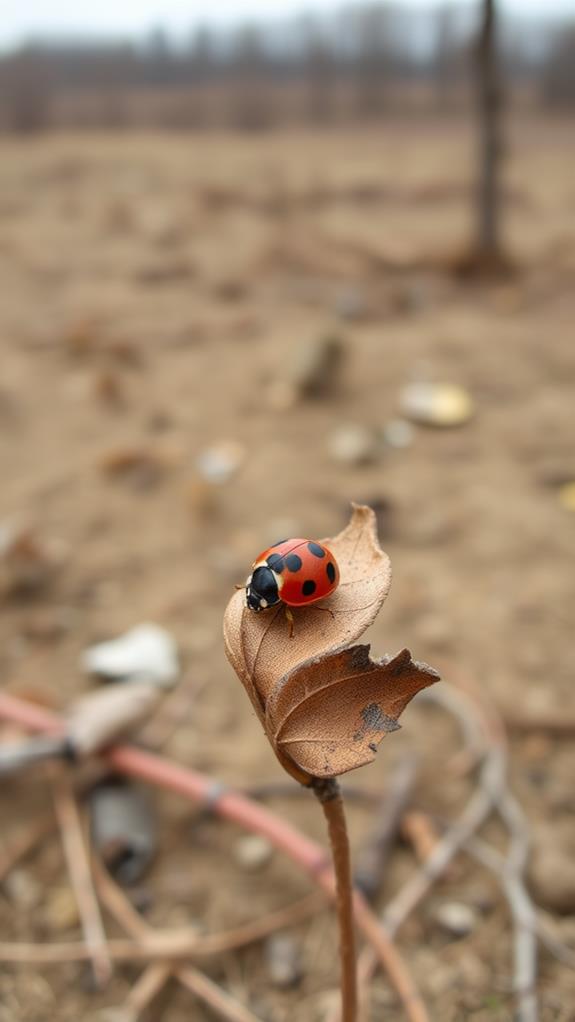
Despite their widespread popularity, ladybugs face serious challenges in the wild. You might be surprised to learn that native ladybug populations in North America have drastically declined in recent years. Many species are now threatened by habitat loss and climate change, with the once-common nine-spotted ladybug experiencing a steep decline in numbers.
Conservation efforts are underway to protect remaining habitats and raise awareness about declining population concerns. Citizen science initiatives, like the Lost Ladybug Project, play an essential role in tracking ladybug populations and engaging the public. These efforts emphasize the importance of organic farming practices and habitat preservation to mitigate factors leading to population decline.
| Threat | Impact | Solution |
|---|---|---|
| Habitat Loss | Reduced breeding grounds | Preserve natural areas |
| Climate Change | Altered food availability | Implement sustainable practices |
| Invasive Species | Competition for resources | Control non-native species |
Invasive species, such as the Asian multicolored ladybug, contribute to the declining populations of native ladybugs in the world by outcompeting them for resources. To address these issues, you can support conservation efforts by participating in citizen science projects and adopting eco-friendly gardening practices that benefit native ladybug species.
Frequently Asked Questions
What Are Rare Facts About Ladybugs?
You might be surprised to learn some rare facts about ladybugs. Did you know they have olfactory organs on their feet? These help them detect predators and food sources. Ladybugs can also be cannibalistic, eating their own eggs or larvae when food is scarce. While many are beneficial, some species, like the Asian multicolored ladybug, can disrupt local ecosystems. During winter, you'll find ladybugs huddling together in massive colonies, sometimes numbering in the thousands, to stay warm.
Are Rainbow Ladybugs Real?
Like a mirage in the desert, rainbow ladybugs aren't quite what they seem. You might've heard of them, but they're not a real species. What you're seeing is the diverse color palette of the ladybug family. With about 5,000 species, ladybugs come in various hues and patterns. Some, like the Harlequin ladybird, can even have multiple color forms. This diversity has led to the misconception of "rainbow" ladybugs. In reality, it's nature's way of providing camouflage and warning coloration against predators.
What Ladybugs Can You Not Touch?
You should avoid touching certain ladybug species, particularly those with defensive mechanisms. The Asian multicolored ladybug can bite if threatened, though it's usually harmless. Some ladybugs excrete a foul-tasting fluid that may irritate sensitive skin. While the seven-spotted ladybug is generally safe, it's best to be cautious. Larval-stage ladybugs often have spiny bodies and unique defensive chemicals, so it's wise to avoid handling them. As a general rule, refrain from touching unfamiliar ladybug species to prevent potential discomfort or irritation.
What Is the Yellow Stuff From Ladybugs?
Did you know that ladybugs can secrete up to 20% of their body weight in hemolymph? This yellow substance you're seeing isn't actually ladybug urine. It's hemolymph, a fluid similar to blood in vertebrates. When threatened, ladybugs release this foul-smelling liquid as a defense mechanism. It contains chemicals that deter predators and can stain surfaces. While it's generally harmless to humans, you might experience a mild allergic reaction if you're sensitive. It's nature's way of protecting these small but resilient insects.





